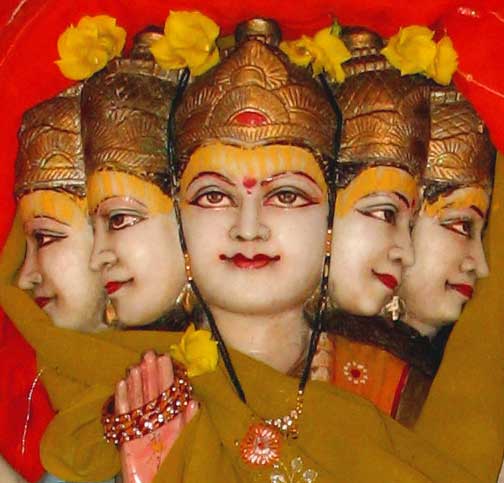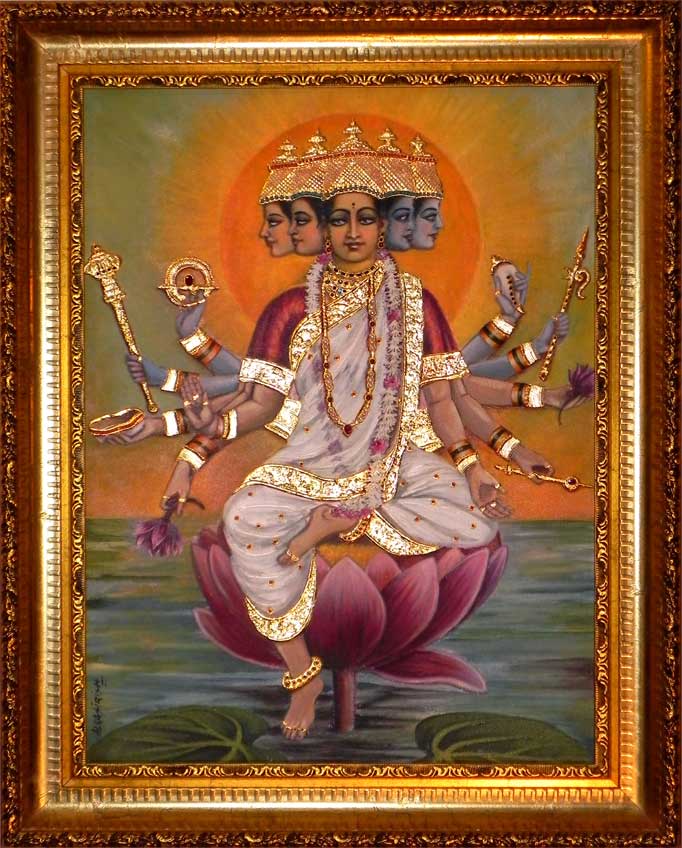
Artists: Alka & Sirish
+91 997125-4488
Shri Ved Mata Gayatri
Shantikunj,
Gayatri Trust, Haridwar (U.P.)
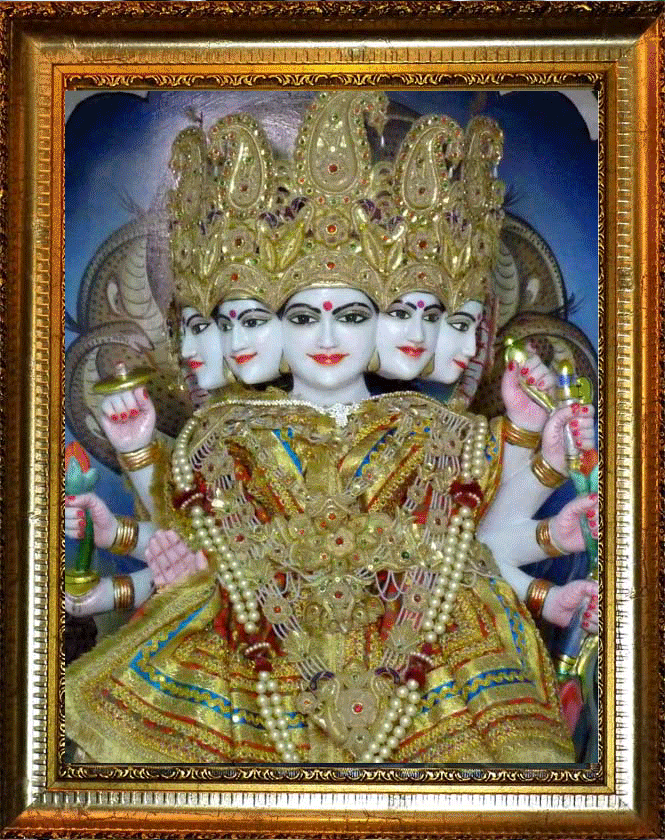
Sri Gayatri Murtis at Brahmavarchas Shantikunj, Haridwar, India
Each Murti personifies one syllable of the mystical Gayatri Mantra.
Learn The Sacred Gayatri Mantra with Vanamali Mataji
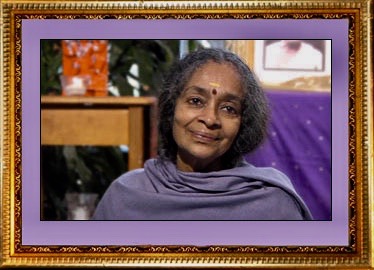
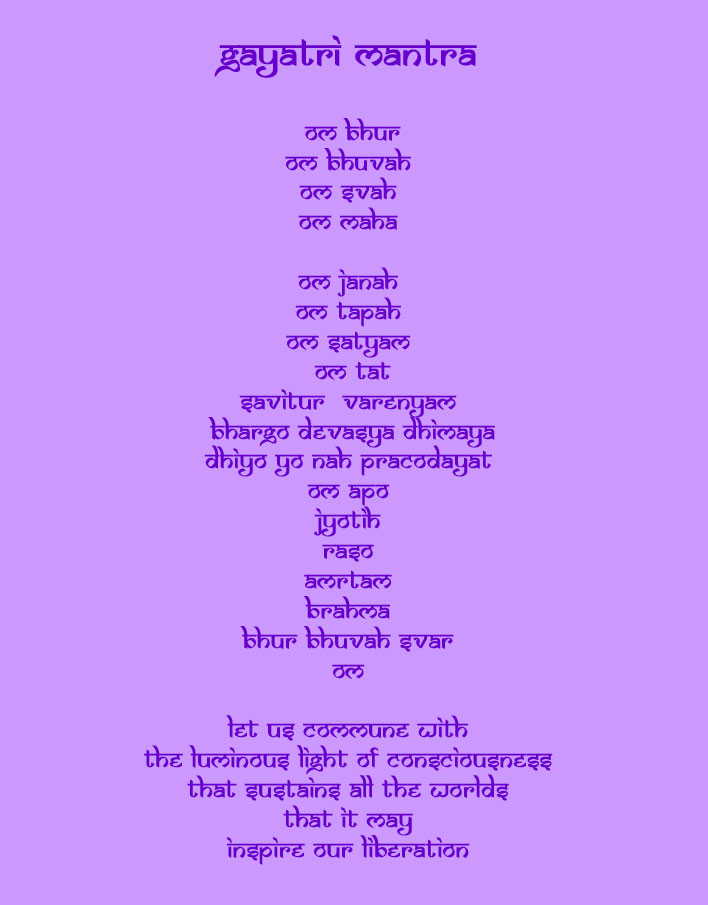 |
Gayatri Invocation Narayana Upanishad
Click Link Below
Gayatri Invocation Narayana Upanishad
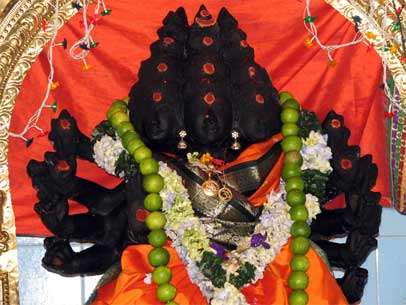 Gayatri Devi, Sri Gayathri Peetam, Nuwara Eliya, Sri Lanka Surya Gayatri
Om Bhur Bhuvah Swaha, Tat savitur varenyam Bhargo devasya dheemahi Dhiyo yonah prachodayath Gayatri is said to be the quintessence of the Vedas. Even though it appears to be a hymn to the solar deity, its esoteric meaning is that it gives us the knowledge of the oneness of the jivatman with the Paramatman - that is the individual soul with the Supreme Soul. Gayatri is also the goddess of the meter in which the hymn is written. She has been personified and extolled and can even be seen by those who have the mystic vision. She is the bestower of all knowledge and has to be worshipped regularly. Normally we face east and look at the rising sun in the morning and towards the west in the evening. “We meditate on that light of the luminous God Savitur, who is well known in the Vedas, who is the inspirer of all beings, their inner Self, who is the creator of the universe. We mediate on that adorable light which is the Self of the Supreme Lord of the universe, adored by all as the sole object of worship. It is the giver of knowledge and destroyer of ignorance. It is the light of the Supreme Brahman itself. May that light enlighten us”. Bhur, bhuvah, svaha! Stands for the three worlds, earth, heaven and inner space. It also stands for existence (bhur), consciousness (bhuvah), (bliss) swaha. Vanamali Mataji 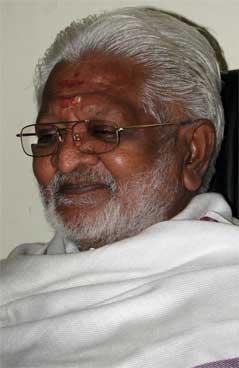 Swami Dr. R.K. Murugesu Sri Gayathri Peetam Nuwara Eliya, Sri Lanka |
Maha Meru Unveiled 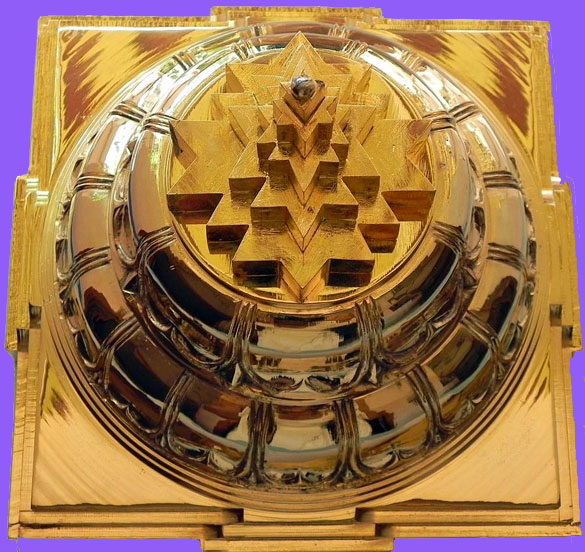 |
Gayatri Devi Omkareshwhar , MP OM BHŪR-BHUVAH-SUVAH TAT-SAVITUR-VARENYAM BHARGO DEVASYA DHĪMAHI DHIYO YO NAH PRACODAYĀT Om, We meditate, Dhīmahi On the Spiritual Effulgence, Bhargas Of that Adorable Supreme Divine Reality, Varenyam Devasya The Source or Projector, Savitr Of the three phenominal world planes... the gross or physical, Bhūh the subtle or psychical, Bhuvah and the potential or causal, Suvah both macrocosmically (externally) and microcosmically (internally). May the Supreme Divine Being, Tat stimulate, Prachdayāt our, Nah intelligence, Dhiyah so that we may realize the Supreme Truth. ¹ ¹OM GĀYATRĪ and SANDHYĀ Swāmī Mukhyānanda Sri Ramakrishna Math, Mylapore Madras, 1989 Gayatri Ashram Omkareshwhar, Dist Kanwa, MP 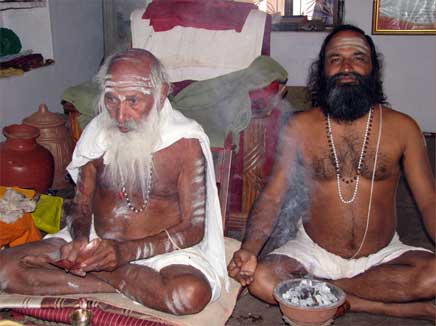 Brragunathji. Maharaj, Pandit Subash Chandra Duba |
| Yet another Scientific explanation of Gayatri Mantra…. 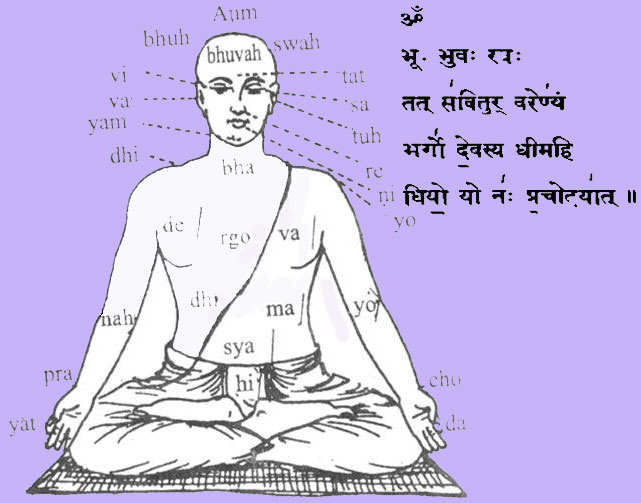 Gayatri Mantra And Its Scientific Meaning Gayatri mantra has been bestowed the greatest importance in Vedic dharma. This mantra has also been termed as Savitri and Ved-Mata, the mother of the Vedas. Om bhur bhuvah swah Tat savitur varenyam Bhargo devasya dheemahi Dhiyo yo nah prachodayat The literal meaning of the mantra is: O God! You are
Omnipresent, Omnipotent and Almighty, You are all Light. You are all
Knowledge and Bliss. You are Destroyer of fear, You are Creator of this
Universe, You are the Greatest of all. We bow and meditate upon Your
light. You guide our intellect in the right direction.
The mantra, however, has a
great scientific importance too, which somehow got lost in the literary
tradition. The modern astrophysics and astronomy tell us that our
Galaxy called Milky Way or Akash-Ganga contains approximately 100,000
million of stars. Each star is like our sun having its own planet
system. We know that the moon moves round the earth and the earth moves
round the sun along with the moon. All planets round the sun. Each of
the above bodies revolves round at its own axis as well. Our sun along
with its family takes one round of the galactic center in 22.5 crore
years. All galaxies including ours are moving away at a terrific
velocity of 20,000 miles per second.
  And now the alternative scientific meaning of the mantra step by step: (A). OM BHUR BHUVAH SWAH: Bhur the earth, bhuvah the
planets (solar family), swah the Galaxy. We observe that when an
ordinary fan with a speed of 900 RPM (rotations Per minute) moves, it
makes noise. Then, one can imagine, what great noise would be created
when the galaxies move with a speed of 20,000 miles per second. This is
what this portion of the mantra explains that the sound produced due to
the fast-moving earth, planets and galaxies is Om. The sound was heard
during meditation by Rishi Vishvamitra, who mentioned it to other
colleagues. All of them, then unanimously decided to call this sound Om
the name of God, because this sound is available in all the three
periods of time, hence it is set (permanent). Therefore, it was the
first ever revolutionary idea to identify formless God with a specific
title (form) called upadhi. Until that time, everybody recognized God
as formless and nobody was prepared to accept this new idea. In the
Gita also, it is said, "Omiti ekaksharam brahma", meaning that the name
of the Supreme is Om , which contains only one syllable (8/12). This
sound Om heard during samadhi was called by all the seers nada-brahma a
very great noise), but not a noise that is normally heard beyond a
specific amplitude and limits of decibels suited to human hearing.
Hence the rishis called this sound Udgith musical sound of the above,
i.e., heaven. They also noticed that the infinite mass of galaxies
moving with a velocity of 20,000 miles/second was generating a kinetic
energy = 1/2 MV2 and this was balancing the total energy consumption of
the cosmos. Hence they named it Pranavah, which means the body (vapu)
or store house of energy
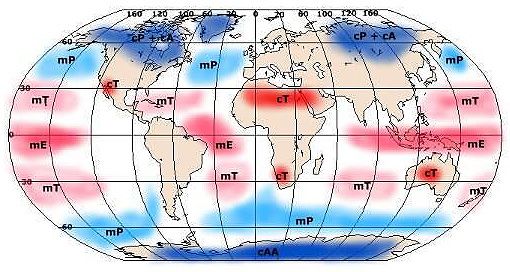 Prana (B). TAT SAVITUR VARENYAM: Tat that (God), savitur
the sun (star), varenyam worthy of bowing or respect. Once the form of
a person along with the name is known to us, we may locate the specific
person.Hence the two titles (upadhi) provide the solid ground to
identify the formless God, Vishvamitra suggested. He told us that we
could know (realize) the unknowable formless God through the known
factors, viz., sound Om and light of suns (stars). A mathematician can
solve an equation x2+y2=4; if x=2; then y can be known and so on. An
engineer can measure the width of a river even by standing at the
riverbank just by drawing a triangle. So was the scientific method
suggested by Vishvamitra in the mantra in the next portion as under:-
(C). BHARGO DEVASYA DHEEMAHI: Bhargo the light, devasya
of the deity, dheemahi we should meditate. The rishi instructs us to
meditate upon the available form (light of suns) to discover the
formless Creator (God). Also he wants us to do japa of the word Om
(this is understood in the Mantra). This is how the sage wants us to
proceed, but there is a great problem to realize it, as the human mind
is so shaky and restless that without the grace of the Supreme (Brahma)
it cannot be controlled. Hence Vishvamitra suggests the way to pray Him
as under:
(D). DHIYO YO NAH PRACHODAYAT: Dhiyo (intellect), yo
(who), nah (we all), prachodayat (guide to right Direction). O God!
Deploy our intellect on the right path. Full scientific interpretation
of the Mantra: The earth (bhur), the planets (bhuvah), and the galaxies
(swah) are moving at a very great velocity, the sound produced is Om ,
(the name of formless God.) That God (tat), who manifests Himself in
the form of light of suns (savitur) is worthy of bowing/respect
(varenyam). We all, therefore, should meditate (dheemahi) upon the
light (bhargo) of that deity (devasya) and also do chanting of Om. May
He (yo) guide in right direction (prachodayat) our(nah) intellect dhiyo.
So we notice that the
important points hinted in the mantra are:-
1) The total kinetic energy generated by the movement of galaxies acts as an umbrella and balances the total energy consumption of the cosmos. Hence it was named as the Pranavah (body of energy). This is equal to 1/2 mv2 (Mass of galaxies x velocity. 2) Realizing the great
importance of the syllable OM , the other later date religions adopted
this word with a slight change in accent, viz., Amen and Ameen.
Balasubramanian.N.K. |
| Savitryai Namaha! SAVITRI (Chapter 26, Sri Devi Lila, Vanamali*) 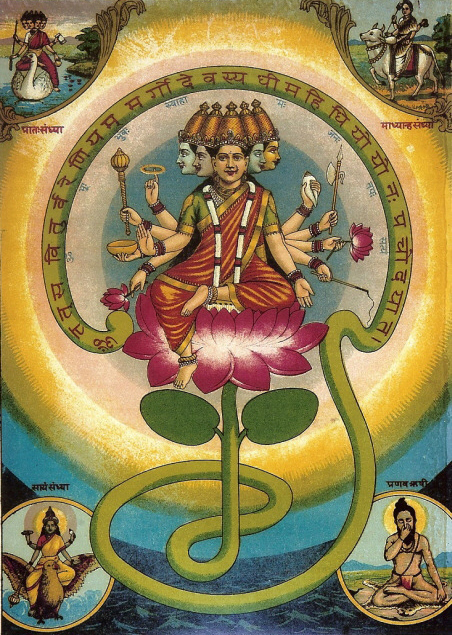 "A power dwelt in her soul too great for earth, A bliss lived in her too large for heaven, Light too intense for thought and love too boundless, For earth's emotions lit her skies of mind And spread though her deep and happy seas of soul All that is sacred in the world drew near, To her divine passivity of mood, A marvelous voice of silence breathed its thoughts, All things in Time and Space she had taken for her. In her they moved, in her they lived and were, The whole wide world clung to her for delight." "Savitri" by Sri Aurobindo In the Vedas the most famous goddess connected with the sun is Ushas,the goddess of dawn. Some of the most beautiful hymns of the Rig Veda are addressed to her. She is described as the daughter of the sky. Night is her sister. At times she is spoken of as the wife of Surya. Ushas is said to travel in a shining chariot, drawn by ruddy horses or cows. The rishis of the Vedas describe her in the most poetic terms. She is a beautiful girl dressed by her mother, a dancing girl covered with jewels and a gaily-attired wife appearing before her husband. Again she is like a fascinating damsel coming out of her bath. Smilingly she unfolds the irresistible power of her attraction and uncovers the cloth covering her bosom. Her quiet modesty is like a shy maiden, conscious of her beauty, ushered into society by her mother. She dispels the darkness not only of the night but also the darkness of ignorance in the minds of human beings. She illumines everything including the darkest recesses of the mind. She is the giver of both life and health. She causes the birds to fly from their nests and like the housewife she sends forth all creatures to attend to the needs of their day's routine. She is eternally young since she is born everyday. Yet she is immeasurably old since she is immortal. She wears out the lives of successive generations, which disappear one after the other while she continues, undying. The souls of the departed are said to go through her and pierce the orb of the sun. "Hall Ushas! Daughter of the sky, Who borne upon thy shining car, By ruddy steeds from realms afar, And ever lightening draws nigh, Thou sweetly smiling, goddess fair, Disclosing all thy youthful grace, Thy bosom bright, thy radiant face, And luster of thy golden hair." "Savitri" by Sri Aurobindo
Savitur refers to the sun god. The famous hymn to the sun god is known as the Gayatri. Actually gayatri is the name of the metre in which it is written. But the metre is conceived of as a goddess - Gayatri. In looks she is something like the Vedic goddess Ushas. The method and practice of the Gayatri Mantra is given in the Savitri Upanishad. Repetition of the Gayatri Mantra is compulsory for all Hindus. It is not meant only for the Brahmins even though the Brahmins were the custodians of this mantra for centuries. Even though it appears to be a hymn addressed to the sun, it is actually addressed to the Supreme Consciousness and is a prayer for enlightenment. It is universally applicable. It is nothing but a prayer for spiritual light addressed to the Almighty. It is addressed to 'Tat Savitur' - 'that sun of Supreme Consciousness', which lights up everything, including the physical sun. The word Savitur is masculine and refers to the sun. The feminine counterpart is the goddess Savitri. This hymn has been regarded as the greatest of all mantras. If there is one mantra,which is common to all Hindus it is this: 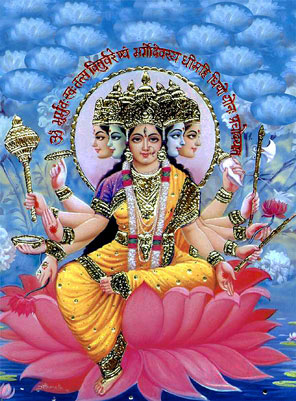 'Aum Bhur Bhuvah Svaha, Tat Savitur Varenyam, Bhargo Devasya Dheemahi, Dhiyo yo nah Prachodayat." "Let us meditate on the Supreme and his glory, Who has created this universe (earth, sky and heaven), Who alone is fit to be worshipped, Who is the remover of all ignorance, May He enlighten us!" At dawn we should turn our face towards the rising sun, which is the visible manifestation of the Supreme Reality and repeat this mantra. At mid-day we should think of the sun at its zenith and repeat the mantra. Again at sunset we should turn towards the setting sun and repeat it once more. It can be repeated as many times as one wishes. The rishis had a thorough knowledge of the subtle effects of sounds and they devised this mantra, which has great mystic power and which will enable the human being to expand his consciousness and allow us to reach the Supreme. Daily repetition of this mystical mantra with sincerity and devotion will help us attain our highest potential, both materially and spiritually. The sun is the abode of the Supreme Brahman. It is the first visible manifestation of the Absolute, The Rig Veda glorifies the sun as 'Pratysha Devata' or the visible divinity. Scientists are only aware of the physical properties of the sun but the sages discovered its spiritual aspect, which is directly linked with the evolution of life and the expansion of intelligence. The rishis realized that the sun has an active spiritual field. They found out that the energy of the sun was born out of the pulsating rhythm of the deep spiritual laws of the Supreme Spirit. They said that it was born, out of 'rita' or the cosmic law of harmony. The basis of the material sun is a great spiritual field, which they called Surya Narayana. The sun is not just a huge mass of atomic energy but a radiant mass of life-giving vitality to all creation. The spiritual values inherent in the sun express themselves in various degrees through different creatures and reach their highest expression in the human being. The sun inspires us to push forward and evolve to the unconditioned freedom of the Absolute. The Gayatri throbs with this intense yearning on the part of the human race to evolve towards its highest potential. Thus, Savitur is nothing but the Supreme itself. Hence the Gayatri mantra is not just a hymn to the sun god but it is a paean of praise to the Supreme Brahman. The goddess Savitri is the presiding deity of the Suryamandala or the solar orb. She is said to be the mother of the Vedas. Brahma in his role as custodian of the Vedas, was the first to worship her. The story of how she came to be born on earth is told in the Puranas. The great sage Sri Aurobindo has written a mystical poem about Savitri which has a great depth of spiritual feeling and symbolism underlying it. in fact the poem is said to have been inspired by the Lalita Sahasranama. Once there was a king of the solar dynasty called Asvapati. He had a highly spiritual-minded queen called Malati. They had no children so their guru, Vasistha, advised her to worship the goddess, Savitri. She went to the holy lake of Pushkara and did tapasya for many years with no result. Dejected, she returned to the palace. Her husband told her not to worry and they should perform their austerities together. They did severe tapasya for a hundred years. At last a celestial voice announced, "Repeat the Gayatri mantra for ten lakhs of times and your wish will be fulfilled." At this time the great sage, Parasara appeared on the scene and told the king of the glory of the Gayatri Mantra. He said, "0 king! If you repeat the Gayatri Mantra just once, all that day's sins will vanish. One hundred repetitions will take away the sins of one year. One lakh destroys the sins of this birth and ten lakhs destroys the sins of other births. If a thousand lakhs is done, liberation is attained". He then instructed the king on the type of japa mala or rosary to be used in counting. "The japa mala should be made of the seeds of the white lotus or of crystal. It should be purified by dipping in milk or Ganga water and consecrated at the feet of one's favorite deity. If a person repeats ten lakhs of mantras on such a mala, he or she will receive the vision of the Devi Savitri. The king performed the rites as commanded by the rishi on the fourteenth day of the black fortnight of the month of jyesta (May/June) for fourteen years. He offered fourteen different types of fruits, flowers and incense to the goddess and distributed wealth to fourteen Brahmins. He used the following mantra to invoke her: "I meditate on that Savitri', the Mother of the Vedas, who has the nature of Aum, and whose color is that of burnished gold. Thou art effulgent like the rays of the noonday sun and adorned with many jewels and ornaments. Thou art the bestower of happiness and liberation, the consort of the Creator. May thou be gracious unto me." Thus repeating this mantra and performing the prescribed rituals for fourteen years, King Asvapati and his queen got the vision of the goddess. She said, "0 king! I know your desire. Your wife wants a daughter and you want a son. You will both get what you want." Thus, having blessed them the goddess returned to the celestial regions. Soon after, the king got a most beautiful daughter whom he named Savitri after the goddess. 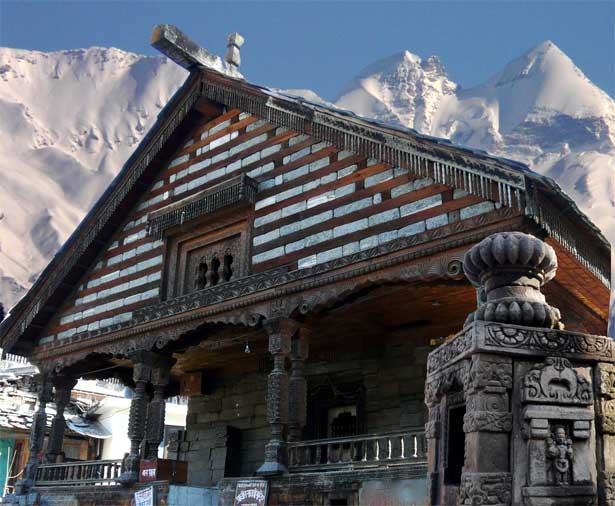 Jagatsukh Gayatri Mandir, Kullu, Himachal Pradesh. When Savitri came of age, the king brought many proposals for her but she would have none of them. She had already seen the man she would marry in one of her excursions into the forest. He was called Satyavan and was the son of the blind king, Dyumatsena. The king had been deposed from his kingdom and had gone to the forest where he lived the life of a sage, accompanied by his faithful wife and son. King Asvapati was not happy with his daughter's choice even though he knew that King Dyumatsena was a noble man and he had heard that his son was the soul of truth and honor. At this time sage Narada came to his court and gave him another distressing bit of news. Looking at Savitri's palm, he told the king that her husband would die after just one year of marriage. The king was grief-stricken and exhorted his daughter to give up her scheme of marrying such a man. But she was adamant and prayed to her mother goddess, Savitri, to give her the courage to stick to her decision and also to give her a long life as the wife of Satyavan. At last the king agreed and gave her in marriage to Satyavan, who. took her back to his hermitage in the forest. For one full year Savitri prayed with all her heart to the goddess, Savitri to grant her the life of her husband. On the concluding day of her vow, which was supposed to be Satyavan's last day on earth, she insisted on accompanying him to the forest when he went to cut wood. As the day wore on, she noticed that Satyavan became more and more exhausted. At last he lay down with his head on her lap. Just at that time, Yama, the god of death, approached and took away Satyavan's life in a noose. With her perception sharpened her austerities, Savitri was able to see all these happenings. She kept the lifeless body of her husband gently on the ground and followed Yama. Yama saw her following him and asked her, "0 Savitri. Why are you following me? No mortal can come with me to my abode. If you want to come with me you will have to shed your body. The time has come for the death of your husband and that is why I am taking him away, but your time has not yet come and you will not be able to follow me to the nether regions. It is only due to your great austerities that you are able to see me at all. The time of birth and death of each being is decreed by their karma. No one can go against their karma" Savitri then asked him to explain the nature of karma and how It could be overcome. Yama said, "Karma is produced by the actions of individuals and is of two kinds, good and bad. Those actions that do not go against the dictates of dharma are considered good and will result in beneficial karma. Actions done for the sake of God without expectation of reward increase devotion to God and lead to liberation. Now Savitri, return to your home and look after your aged parents. This is your dharma at the moment". Savitri said, "A wife's dharma is to follow her husband wherever he goes Where shall I go leaving my husband? Pray! instruct me, for you are the greatest of all teachers". Yama said, "0 Savitri! You are a portion of the goddess and hence you are precocious beyond your years and filled with knowledge. Ask three boons from me and I shall grant them". Savitri immediately said, "Let me have a hundred sons by my husband satyavan. Let my father-in-law get back his eyesight and his kingdom and let my father have many sons~'. Yama agreed to this and swiftly Savitri said, "0 gracious Lord! How will I get sons from Satyavan unless you give back his life"? Yama was pleased by her presence of mind and perseverance and deep devotion to her husband and said, "My child, I am pleased with your devotion and intelligence. Worship Devi Savitri who is none other than Mula Prakriti and all happiness shall be yours. Take your husband and return to your home and live happily with him. Undertake the Savitri vow for fourteen years which is what your parents did and you certainly attain liberation along with your husband". 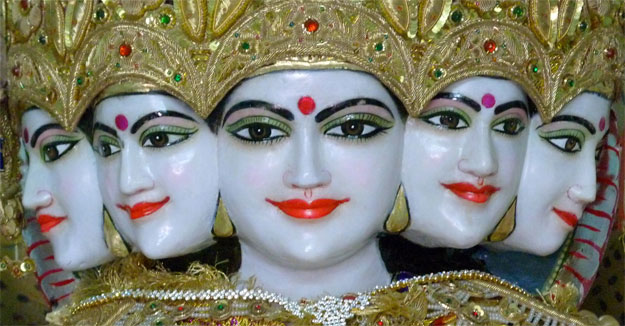 Shri Ved Mata Gayatri Shantikunj, Gayatri Trust, Haridwar (U.P.) Saying this, Yama blessed Savitri and told her to go back to the spot where she had placed the corpse of her husband. When Savitri returned to the tree under which she had kept her husband's body, she found him getting up as if from deep sleep. He had no memory of what had happened and thought he had fallen asleep. She told him the whole saga and they rejoiced at his miraculous return from the land of the dead. They returned to the hermitage and repeated this wonderful tale. Soon after, Dyumatsena got back his eyesight and kingdom and they went back to their land and worshipped the goddess as advised by Yama. Savitri's parents also got many sons as promised by Yama. All of them attained liberation from their mortal coils after many blessed years spent in conducting the affairs of the kingdom worshipping the goddess Savitri, and by repeating the Gayatri Mantra. "She pressed the living body of Satyavan; On her body's wordless joy to be and breathe, She bore the blissful burden of his head, Between her breasts, warm labour of delight, The waking gladness of her members felt, The weight of heaven in his limbs, a touch Summing the whole felicity of things, And all her life was conscious of his life, And all her being rejoiced enfolding his, The immense remoteness of her trance had passed; Human she was once more, earth's Savitri, Yet felt in her illimitable change." "Savitri" by Sri Aurobindo
Thus ends the twenty-sixth chapter of the Sri Devi Lila known as 'Savitri' which narrates the story of Goddess Savitri and her descent to the earth. Aim, Hreem, Kleem * Sri Devi Lila, Vanamali, Aryan Books International, New Delhi, 2006 Published in the US as Shakti: Realm of The Divne Mother, Inner Traditions, 2009 |
home
